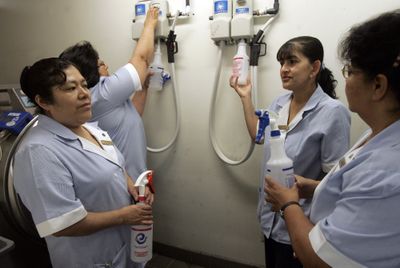Cheap, chemical-free sanitizer gets notice

LOS ANGELES – It’s a kitchen degreaser. It’s a window cleaner. It kills athlete’s foot. Oh, and you can drink it.
Sounds like the old “Saturday Night Live” gag for Shimmer, the faux floor polish plugged by Gilda Radner. But the elixir is real. It has been approved by U.S. regulators. And it’s starting to replace the toxic chemicals Americans use at home and on the job.
The stuff is a simple mixture of table salt and tap water whose ions have been scrambled with an electric current. Researchers have dubbed it electrolyzed water – hardly as catchy as Mr. Clean. But at the Sheraton Delfina in Santa Monica, some hotel workers are calling it “el liquido milagroso” – the miracle liquid.
That’s as good a name as any for a substance that scientists say is powerful enough to kill anthrax spores without harming people or the environment.
Used as a sanitizer for decades in Russia and Japan, it’s slowly winning acceptance in the United States. A New York poultry processor uses it to kill salmonella on chicken carcasses. Minnesota grocery clerks spray sticky conveyors in the checkout lanes. Michigan jailers mop with electrolyzed water to keep potentially lethal cleaners out of the hands of inmates.
In Santa Monica, the once-skeptical Sheraton housekeeping staff has ditched skin-chapping bleach and pungent ammonia for spray bottles filled with electrolyzed water to clean toilets and sinks.
“I didn’t believe in it at first because it didn’t have foam or any scent,” said housekeeper Flor Corona. “But I can tell you it works. My rooms are clean.”
Management likes it, too. The mixture costs less than a penny a gallon. It cuts down on employee injuries from chemicals. It reduces shipping costs and waste because hotel staffers prepare the elixir on site. And it’s helping the Sheraton Delfina tout its environmental credentials to guests.
“It’s green. It saves money. And it’s the right thing to do,” said Glenn Epstein, executive assistant at the Sheraton Delfina. “It’s almost like fantasy.”
Actually, it’s chemistry. For more than two centuries, scientists have tinkered with electrolysis, the use of an electric current to bring about a chemical reaction. That’s how we got metal electroplating and large-scale production of chlorine, used to bleach and sanitize.
It turns out that zapping salt water with low-voltage electricity creates a couple of powerful yet nontoxic cleaning agents. Sodium ions are converted into sodium hydroxide, an alkaline liquid that cleans and degreases like detergent, but without the scrubbing bubbles. Chloride ions become hypochlorous acid, a potent disinfectant known as acid water.
“It’s 10 times more effective than bleach in killing bacteria,” said Yen-Con Hung, a professor of food science at the University of Georgia-Griffin, who has been researching the water for more than a decade. “And it’s safe.”
There are drawbacks.
Electrolyzed water loses its potency fairly quickly, so it can’t be stored long. Machines are pricey and geared mainly for industrial use. The process also needs to be monitored frequently for the right strength.
Richard Wullaert, a Santa Barbara, Calif., consultant, said consumers should be careful.
“Some of these people are making claims that will get everybody in trouble,” said Wullaert, whose nonprofit Functional Water Society is spreading the word about electrolyzed water. “It’s time for some serious conferences with serious scientists to give this credibility.”
Most of the growth has happened outside the United States.Russians are putting electrolyzed water down oil wells to kill pesky microbes. Europeans use it to treat burn victims. Electrolyzing equipment is helping to sanitize drinking water in parts of Latin American and Africa.
In the U.S., the Department of Agriculture, the Food and Drug Administration and the Environmental Protection Agency have approved electrolyzed water for a variety of uses.
Electrolyzer Corp. of Woburn, Mass., is going after the hospitality market. The Sheraton Delfina in Santa Monica purchased one of its machines. It looks like an oversized water heater, with two tanks side by side – one for making the hypochlorous acid sanitizer, the other for the sodium hydroxide cleanser.
Minnesota food scientist Joellen Feirtag found that the acid water killed E. coli, salmonella, listeria and other nasty pathogens.
She’s now encouraging food processors to consider it in combating the disease outbreaks that have roiled the industry.